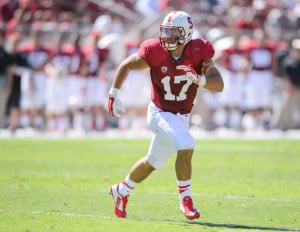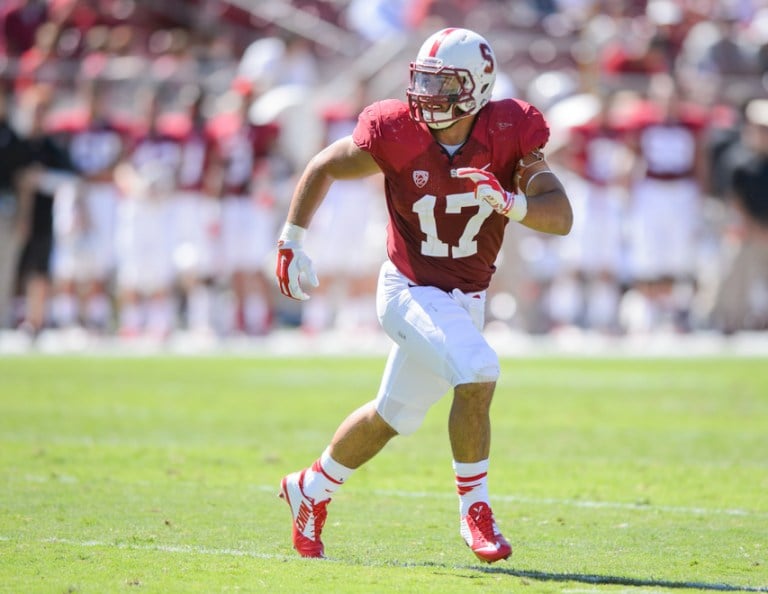A lot has changed in Seattle since Stanford football last visited in 2012.
For one, there’s a new coaching staff, headed by mastermind Chris Petersen of Boise State fame. Secondly, there are new faces on the offense, with stalwarts like Keith Price, Bishop Sankey and Austin Sefarian-Jenkins all having departed to the pros. There’s also a new venue, as CenturyLink Field has been phased out in favor of the new Husky Stadium.

But one thing will be the same: the noise.
Husky fans always show up in full force to support their home team, and according to fifth-year senior inside linebacker A.J. Tarpley, the 2012 road game in Seattle presented the loudest road environment he had ever played in. For a Stanford team playing its first road game of the season, preparing for the hostile fans in Seattle has been just one of many elements that will be present throughout the last week of practice.
“We have the speakers; they’ll be cranked up all week,” said head coach David Shaw. “Which is great, because you can’t count on hearing. We’ve never been to the stadium. Of course, we’ve played at Oregon and at the old Husky Stadium, which was also extremely loud. This is supposed to be just as loud, if not louder.”
Even with the additional challenge, however, senior quarterback Kevin Hogan is confident that the offense will not have any issues. According to the signal-caller, the team has made big strides in its nonverbal communication, particularly along the offensive line, and although the line has struggled at times this season, he believes that it is ready for its first road challenge.
Shaw also believes that for the young offensive line, going out into the hostile road environment and making the calls in the noise will be an important next step. The coaching staff has also been aware of these challenges and will be making sure to not give the line too many things to consider so that they won’t get confused.
“It is different when you get out there on the road and it’s real crowd noise as opposed to just loud music at practice,” Hogan said. “But we’ve been working on it and we have all of our signals down. I think they’re going to be fine… It’s easy for them to see what I’m trying to get.”
And for the defense, life will actually get easier on the road, as noise will be less of a factor with the fans set to quiet down when their Huskies’ offense takes the field, making communication easier for Stanford’s defenders. That’s probably one of the reasons why Tarpley actually likes going on the road, along with the mentality that it incites in him.
“It’s kind of a you against the world mentality,” Tarpley said. “It just kind of gives you an extra burst when you’re out there playing… When you’re playing defense, all it takes is one play when you let up and the whole stadium will explode. Keeping that hush quiet is what we like to do.”
In order to keep that hush quiet, Tarpley and the nation’s leading scoring defense will need to silence a Huskies offense that has looked inconsistent for vast stretches of the season thus far but still presents a formidable challenge due to the talent all across the roster.
Shaw specifically spoke about the necessity to keep Washington quarterback Cyler Miles in the pocket and not let him escape due to the 6-foot-4, 225-pound sophomore’s ability to create more time with his legs. In addition, Petersen’s scheme has led to the introduction of many different subtleties in the offense that Shaw has had to prepare his team for.
“There are a bunch of nuances to what they do on the offensive side,” Shaw said. “If you overplay one thing, they’ll take advantage of something else, so we have to be very sound in everything we do defensively.”
In order to get accustomed to defending that new scheme, the team and coaches have not only been watching Washington film from this year, but also old Boise State film from when the Broncos were led by Petersen. Washington film from previous years has taken a backseat due to the difference in scheme and also because Shaw believes that the team is already familiar enough with Washington’s personnel.
Stanford’s defense will get a boost from sophomore linebacker Kevin Palma receiving a completely clean bill of health but will likely still be missing versatile fifth-year senior Joe Hemschoot, who has the capability to not only fill in at both inside and outside linebacker but also has the skills to step in at nickelback if needed. Although Hemschoot’s status is still deemed questionable, Shaw does not expect him to play on Saturday. On the offensive side, senior tailback Remound Wright has also been deemed completely healthy.
Shaw is optimistic about the team moving forward, saying that this last week of practice has been the best week of practice so far this season, and that the red-zone issues that plagued the team in the loss to USC are entirely fixable. In that mindset as well, the team has been paying particular attention to ball security over the last several weeks after the Cardinal have uncharacteristically fumbled nine times over the first three games, five of which have resulted in turnovers.
Shaw reiterated his two keys to winning football games: playing good defense and not turning the ball over. With Hogan showing vast improvement in the latter by only having thrown one interception in 88 passing attempts, the fumbles will need to come down in the coming weeks for Shaw to be comfortable.
This past bye week gave Stanford plenty of extra time to shore up that deficiency, game plan for Saturday and get rest just in time for the start of school. It’ll be up to the Cardinal to show this weekend that they have improved enough to make a statement against a solid Washington team that represents another threat to the Cardinal in the deep Pac-12 North.
Contact Do-Hyoung Park at dpark027 ‘at’ stanford.edu.
